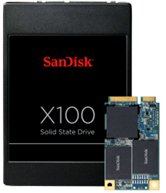
Posted on Wednesday, February 15 2012 @ 20:27 CET by Thomas De Maesschalck
SanDisk introduced the X100 SSD:
SanDisk Corporation (NASDAQ: SNDK), a global leader in flash memory storage solutions, today announced the SanDisk® X100 solid state drive (SSD) for client computing markets. The SanDisk X100 SSD is available in capacities up to 512GB and utilizes multi-level cell (MLC) technology, a SATA 6Gb/s high-performance interface, advanced multi-streaming features and tiered caching technology.
The drive offers up to 500/420 megabyte per second (MB/sec) sequential read/write speeds, and enables a user to copy a 4GB high-definition movie in less than 10 seconds*. In addition to the standard 2.5 inch form factor, the X100 SSD also comes in mSATA and customized thin form factors to address the emerging ultra-thin laptop market. SanDisk offers a wide variety of configuration options, including standalone and dual drive caching solutions.
"With the introduction of the X100 SSD, SanDisk now offers OEMs a complete selection of SSD storage choices," said Kevin Conley, senior vice president and general manager, client storage solutions, SanDisk. "From the smallest BGA form factors of the iSSD to the economical lower power U100, all the way up to the high performance and high capacity points of our new X100, SanDisk offers a solution to meet the needs of notebook, desktop and ultra-thin laptop manufacturers."
The SanDisk X100 SSD achieves long-term reliability through robust, continual background error checking and advanced NAND recovery mechanisms. The drive is available now for sampling to PC manufacturers and production-volume shipments.
Specifications:
Performance: Up to 500/420 MB/s sequential read/write speeds
Capacity: 32GB, 64GB, 128GB, 256GB, 512GB
Form Factor: Cased 2.5 inch 7mm or 9.5mm, mSATA and customized form factors
Interface: SATA 6Gb/s
Power Consumption: Active Power (Typical)**: 150mW (@ 3.3V) / Standby Mode (Typical)***: 75mW (@ 3.3V)
Reliability: MTBF up to two million hours
Target Platforms: Ultrabook, notebook, and desktop computers

